In this article, You will read the Soil Genesis i.e. Formation of Soil for Geography Optional UPSC (Biogeography).
Soil formation is a complicated natural process of soil origination from mountain rock under the effects of the soil-forming factors in natural or anthropogenic ecosystems of the Earth. Soil formation is a global biospheric process, and as a result of its manifestation, soil attains a number of typical features, that are absent in the soil-forming rock and distinguish the soil from other components of the biosphere.
What is Soil?
It is the uppermost layer of Earth’s crust, formed by the continuous weathering of mountains over thousands of years. It is made up of four basic constituents; minerals, organic materials, air, and water. The three main components responsible for its texture are; sand, silt, and clay. Depending upon these three constituents the mineral texture of the soil varies. Leaves and organic constituents decompose to form the upper organic layer, known as humus. The humus content in soils plays a very important role in its fertility.
Soil Genesis
Soils constitute a major element in the natural environment, linking climate and vegetation, and they have a profound effect on man’s activities through their relative fertility. The scientific study of soils is known as pedology; the process of soil formation is referred to as pedogenesis (soil genesis).
Soil is the upper weathered layer of the Earth’s crust affected by plants and animals. A vertical section through this zone constitutes a soil profile; in each soil profile, there are usually several distinguishable layers or horizons, which enable different types of soil to be recognized.
- Soil is a relatively thin surface layer of mineral matter that normally contains a considerable amount of organic material and is capable of supporting living plants.
- It occupies that part of the outer skin of Earth that extends from the surface down to the maximum depth to which living organisms penetrate, which means basically the area occupied by plant roots. Soil is characterized by its ability to produce and store plant nutrients, an ability made possible by the interactions of such diverse factors as water, air, sunlight, rocks, plants, and animals.
- Although thinly distributed over the land surface, soil functions as a fundamental interface where the atmosphere, lithosphere, hydrosphere, and biosphere meet. The bulk of most soil is an inorganic material, so the soil is usually classified as part of the lithosphere, but it is intimately related to the other three Earth spheres.
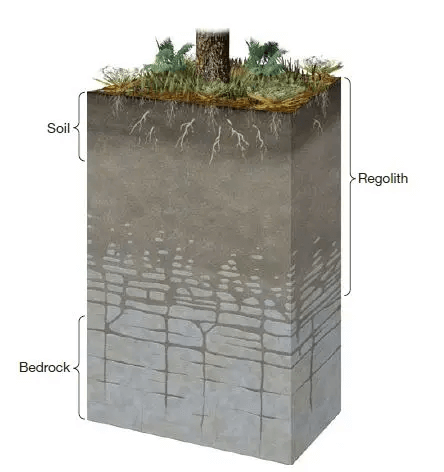
Soil development (Genesis of Soil-Structure) begins with the physical and chemical disintegration of rock exposed to the atmosphere and to the action of water percolating down from the surface. This disintegration is called weathering. The basic result of weathering is the weakening and breakdown of solid rock, the fragmentation of coherent rock masses, and the making of little rocks from big ones.
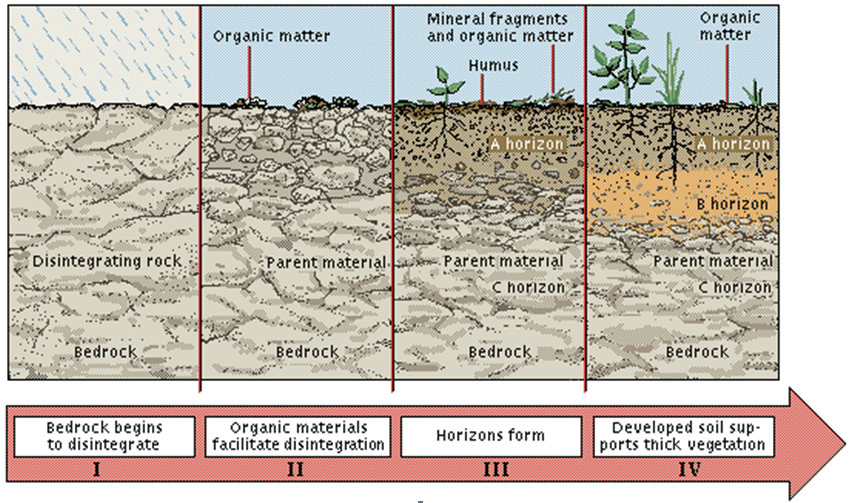
- The principal product is a layer of loose inorganic material called regolith (“blanket rock”) because it lies like a blanket over the unfragmented rock below. Typically then, the regolith consists of material that has weathered from the underlying rock and that has a crude gradation of particle sizes, with the largest and least fragmented pieces at the bottom, immediately adjacent to the bedrock.
- Sometimes, however, the regolith consists of material that was transported from elsewhere by the action of wind, water, or ice. Thus, the regolith may vary significantly in composition from place to place.
- The upper half-meter or so of the regolith normally differs from the material below in several ways, most notably in the intensity of biological and chemical processes taking place.
- This upper portion is soil. It is composed largely of finely fragmented mineral particles and is the ultimate product of weathering. It normally also contains an abundance of living plant roots, dead and rotting plant parts, microscopic plants and animals both living and dead, and a variable amount of air and water. Soil is not the end product of a process, but rather a stage in a neverending continuum of physical-chemical–biological processes.
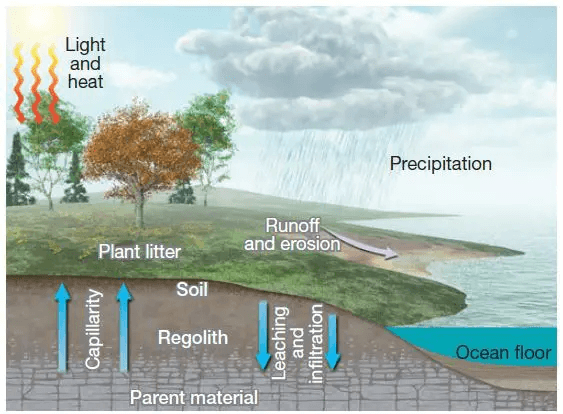
Soil-forming Processes
There are four classes of soil-forming processes: soil enrichment, removal, translocation, and transformation.
Soil Enrichment
In soil enrichment, matter—organic or inorganic—is added to the soil. Surface mineral enrichment of silt by river floods or as wind-blown dust is an example. Organic enrichment occurs as water carries humus from the O horizon into the A horizon below.
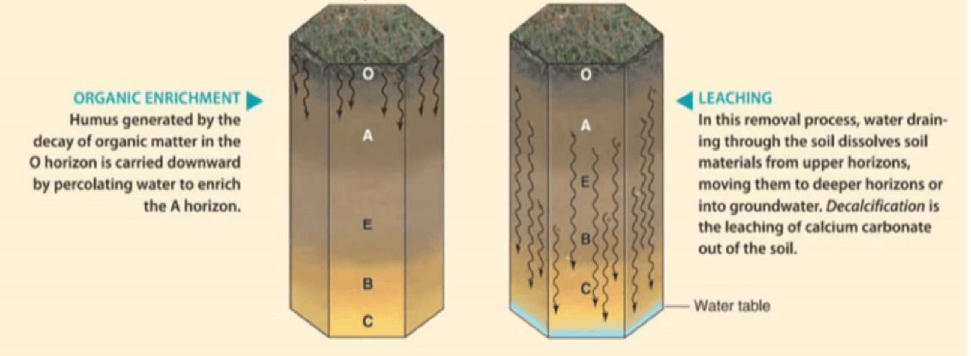
Removal Process
In removal processes, the material is removed from the soil body. This occurs when erosion carries soil particles into streams and rivers. Leaching, the loss of soil compounds and minerals by solution in water flowing to lower levels is another important removal process.
Cheluviation is the downward movement of materials in the soil which is very similar to leaching. However, cheluviation occurs through the influence of organic agents which are also referred to as chelating agents. The process involves plant acids rather than mere water as the case with leaching.
Translocation Process
Translocation describes the movement of materials upward or downward within the soil.
Downward Translocation:
Fine particles particularly clays and colloids are translocated downward, a process called eluviation. This leaves behind grains of sand or coarse silt, forming the E horizon. Material brought downward from the E horizon—clay particles, humus, or sesquioxides of iron and aluminum—accumulates in the B horizon, a process called illuviation.
The topmost layer of the soil is a thin deposit of wind-blown silt and dune sand, which has augmented the soil profile. Humus, moving downward from decaying organic matter in the O horizon, has enriched the A horizon, giving it a brownish color. Eluviation has removed colloids and sesquioxides from the whitened E horizon, and illuviation has added them to the B horizon, which displays the orange-red colors of iron sesquioxide.
The translocation of calcium carbonate is another important process. In moist climates, a large amount of surplus soil water moves downward to the groundwater zone. This water movement leaches calcium carbonate from the entire soil in a process called decalcification. Soils that have lost most of their calcium are also usually acidic, and so they are low in bases. Adding lime or pulverized limestone will not only correct the acid condition but will also restore the missing calcium, an important plant nutrient.
In dry climates, annual precipitation is not sufficient to leach the carbonate out of the soil and into the groundwater below. Instead, it is carried down to the B horizon, where it is deposited as white grains, plates, or nodules, in a process called calcification. Calcification can produce a cemented layer, known as a hard pan that interferes with both eluviation and illuviation. This renders the soil less fertile by preventing the exchange of nutrients.
In colder climates, a pan can also form from the accumulation of oxides of iron and aluminum by illuviation. This type of pan can block drainage and keep the soil saturated for long periods, resulting in chemical reducing conditions.
Upward translocation:
Upward translocation can also occur in desert climates. In some low areas, a layer of groundwater lies close to the surface, producing a flat, poorly drained area. As the water at or near the soil surface evaporates, groundwater is drawn upward to replace it by capillary tension, much like a cotton wick that draws oil upward in an oil lamp. This groundwater is often rich in dissolved salts. When the salt-rich water evaporates, the salts are deposited and build up. This process is called salinization. Large amounts of these salts are toxic to many kinds of plants. When salinization occurs in irrigated lands in a desert climate, the soil can be ruined, with little hope of revival.
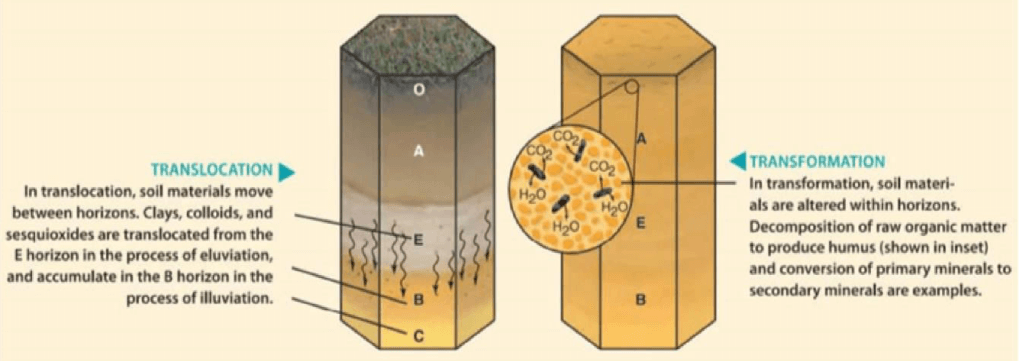
Transformation Process
The last class of soil-forming processes involves the transformation of material within the soil body. An example is the conversion of minerals from primary to secondary types, another example is the decomposition of organic matter by microorganisms to produce humus, a process termed as humification. In warm moist climates, the transformation of organic matter to carbon dioxide and water can be nearly complete, leaving virtually no organic matter in the soil.
Soil Forming Factors
Soil is an ever-evolving material. Metaphorically, soil acts like a sponge – taking in inputs and being acted upon by the local environment – changing over time and when the inputs or local environment change.
Factors that are responsible for soil development are –
- Climate
- Organisms
- Relief
- Parent Material
- Time
- Human Activity
Climate
Climate, measured by precipitation and temperature, is an important determinant of soil properties. As we have seen, precipitation controls the downward movement of nutrients and other chemical compounds in soils by translocation. If precipitation is high, water will wash nutrients deeper into the soil and out of reach of plant roots. If precipitation is low, salts will build up in the soil and restrict fertility.
Soil temperature affects the chemical development of soils and the formation of horizons. Below 10°C, biological activities are slowed; and at or below the freezing point (0°C; 32°F), biological activity stops, and chemical processes affecting minerals are inactive. Thus, decomposition is slow in cold climates, and so organic matter accumulates to form a thick O horizon. This material becomes humus, which is carried downward to enrich the A horizon.
In contrast, bacteria rapidly decompose plant material in the warm, moist climates of low latitudes. O horizons are lacking, and the entire soil profile will contain very little organic matter.
- Role of precipitation: In areas that experience a lot of rainfall, water percolating down through soil tends to leach nutrients and organic matter out of the upper layers, unless modified by other soil components like plant roots.
- E.g. the soils underlying tropical rain forests tend to be nutrient-poor because of intensive leaching due to heavy rains; most of the nutrients are stored in the lush vegetation itself.
- Conversely, in arid regions with little annual precipitation, high rates of evaporation encourage the accumulation of salts in the soil.
- Role of temperature: Solar energy, usually expressed as temperature, controls the form of water falling onto the soil surface as well as in the soil. Also, it increases the rate of reactions, such as chemical reactions, evapotranspiration, and biological processes. Wide fluctuations in temperature, especially in the presence of water cause shrinking and swelling, frost action, and general weathering in soils.
- E.g. Laterite soils are found in the alternate wet and dry climate.
- In Rajasthan, both granite and sandstone give birth to sandy soil irrespective of parent rock because of high temperature and wind erosion.
Organisms
Living plants and animals, as well as their nonliving organic products, have an important effect on soil. Plant roots, by their growth, mix and disturb the soil and provide organic material directly to upper soil horizons.
Organisms living in the soil include many species, from bacteria to burrowing mammals. Earthworms continually rework the soil not only by burrowing, but also bypassing soil through their intestinal tracts. And moles, gophers, rabbits, badgers, prairie dogs, and other burrowing animals make larger, tube-like openings.
The cultivating and mixing activities of earthworms are of great value in improving the structure, increasing the fertility, lessening the danger of accelerated erosion, and deepening the profile of the soil. The distinctive evidence of this value is that the presence of many well- nourished earthworms is almost always a sign of productive, or potentially productive, soil.

Relief
The configuration, or shape, of the ground surface, known as relief, also influences soil formation. Generally speaking, soil horizons are thick on gentle slopes and thin on steep slopes. This is because the soil is more rapidly removed by erosion on the steeper slopes. In addition, slopes facing away from the Sun are sheltered from direct insolation and so tend to have cooler, moister soils. Slopes facing toward the Sun are exposed to direct solar rays, raising soil temperatures and increasing evapotranspiration.
Topography redistributes the water reaching the soil surface. Runoff from uplands creates wetter conditions on the lowlands, in some cases saline sloughs or organic soils. Thus, as a redistributor of the climate features, topography affects soil processes, soil distribution, and the type of vegetation at the site.
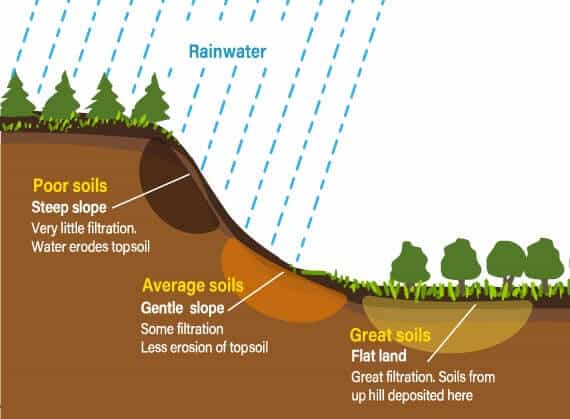
Parent Material
Soil chemistry is influenced by the original source of the parent material. For example, iron-rich bedrock produces soils rich in iron oxides, whereas limestone forms calcium-rich soils. Some types of secondary minerals, weathered from particular primary minerals, can produce soils with unique properties. Also, soil texture is largely determined by the size of mineral grains within the parent material.
Soil inherits many properties from the parent material from which it forms, for example, the mineral composition, the colour, the particle size and the chemical elements.
For Example,
- The peninsular soils reflect the parent rock very much.
- The ancient crystalline and metamorphic rocks which are basically granite, gneiss, and schist form red soils on weathering because they contain iron oxide.
- Soils derived from lava rocks are black coloured.
- Sandy soils are derived from sandstone.
- At the same time, the soils of the northern plains are transported and deposited from Himalayan and peninsular blocks, so they have little relation to rock material in-situ.
Time
The characteristics and properties of soils require time for development. For example, a fresh deposit of mineral matter, like the clean, sorted sand of a dune, may require hundreds to thousands of years to acquire the structure and properties of sandy soil.
Soil-forming processes are generally very slow, and many centuries may be required for a thin layer of soil to form on a newly exposed surface. A warm, moist environment is conducive to soil development. Normally of much greater importance, however, are the attributes of the parent material. For example, soil develops from sediments relatively quickly and from bedrock relatively slowly.
A soil scientist’s rule of thumb is that it takes about 500years to form 2.5 cm (1 in.) of topsoil.
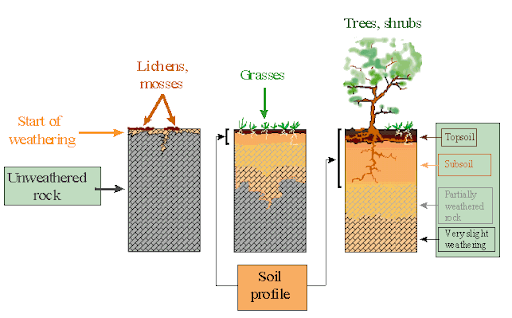
Human Activity
Human activity also influences the physical and chemical nature of the soil. Clearing of native vegetation for crops can induce erosion, removing upper layers that are rich in organic matter. Large areas of agricultural soils have been plowed and planted for centuries. As a result, both the structure and composition of these agricultural soils have undergone great changes. These altered soils are often recognized as distinct soil classes that are just as important as natural soils.
Soil Composition
Soil is one of the most important elements of an ecosystem, and it contains both biotic and abiotic factors.
Soil contains air, water, and minerals as well as plant and animal matter, both living and dead. These soil components fall into two categories.
In the first category are biotic factors—all the living and once-living things in the soil, such as plants and insects.
The second category consists of abiotic factors, which include all nonliving things—for example, minerals, water, and air.
The most common minerals found in soil that support plant growth are phosphorus, and potassium and also, nitrogen gas. Other, less common minerals include calcium, magnesium, and sulfur.
Soils usually (or averagely) made up of about 25% air, 25% water, 45% mineral, and 5% organic matter (humus, tiny living organisms, and sometimes plant residue).
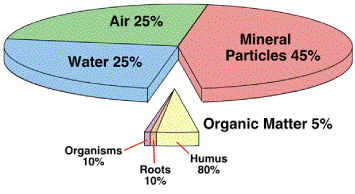

Every topic is explained in a lucid manner !! great work by the team loustarise. Keep going.
Thanks, Keep reading
sir can u provide same material in hindi..i lov ur great effort to minimize my labour in geography..thanku so much
no
you can use google translate extension
Very understandable and detailed. Thankyou for spreading knowledge. Keep up the good work.
Fabulous explanation of every topic is USP of lotusarise…..keep going…..
Can’t explain in words i can say only marvellous.
Thanks
Very nicely explained 😊
woww…..everything at one place..notes..diagram…3d pics
Superb content 🥰🥰🥰
It is very understandable
Excellent. So easy to understand. Can you please do work on Indian economy if it’s possible.
Thank you so much sir for this efforts
Thankyou so much Lotus arise team 🙏